Standard [CURRENT]
ASTM E 299:2025
Standard Test Method for Trace Amounts of Peroxides In Organic Solvents
- Publication date
- 2025
- Original language
- English
- Pages
- 6
- Publication date
- 2025
- Original language
- English
- Pages
- 6
- DOI
- https://dx.doi.org/10.1520/E0299-25
Product information on this site:
Quick delivery via download or delivery service
Buy securely with a credit card or pay upon receipt of invoice
All transactions are encrypted
Short description
1.1 This test method 2 , 3 covers organic solvents containing active oxygen in the range from 5 μg/g (ppm) to 80 μg/g (ppm) or higher. By using a special reaction-absorption cell, the test method can be extended to cover the range from 0 ppm to 5 ppm. The test method can be used to determine numerous peroxide classes of varying reactivity such as hydroperoxides, diacyl peroxides, diaroyl peroxides, peresters, and ketone peroxides. The stable di- tert -alkyl peroxides do not react under the conditions of analysis. 1.2 Solvents that can be analyzed successfully include saturated and aromatic hydrocarbons, alcohols, ethers, ketones, and esters. In addition, the test method is applicable to olefinic solvents and to certain compounds that contain α , β , and conjugated unsaturation. Solid samples that are soluble in the acetic acid-chloroform solvent also can be analyzed. 1.3 The values stated in SI units are to be regarded as standard. The values given in parentheses are for information only. 1.4 In determining the conformance of the test results using this method to applicable specifications, results shall be rounded in accordance with the rounding off methods of Practice E29 . 1.5 This standard does not purport to address the safety concerns, if any, associated with its use. It is the responsibility of the user of this standard to establish appropriate safety, health, and environmental practices and determine the applicability of regulatory limitations prior to use. 1.6 This international standard was developed in accordance with internationally recognized principles on standardization established in the Decision on Principles for the Development of International Standards, Guides and Recommendations issued by the World Trade Organization Technical Barriers to Trade (TBT) Committee.
ICS
71.100.99
DOI
https://dx.doi.org/10.1520/E0299-25
Also available in
Loading recommended items...
Loading recommended items...
Loading recommended items...

